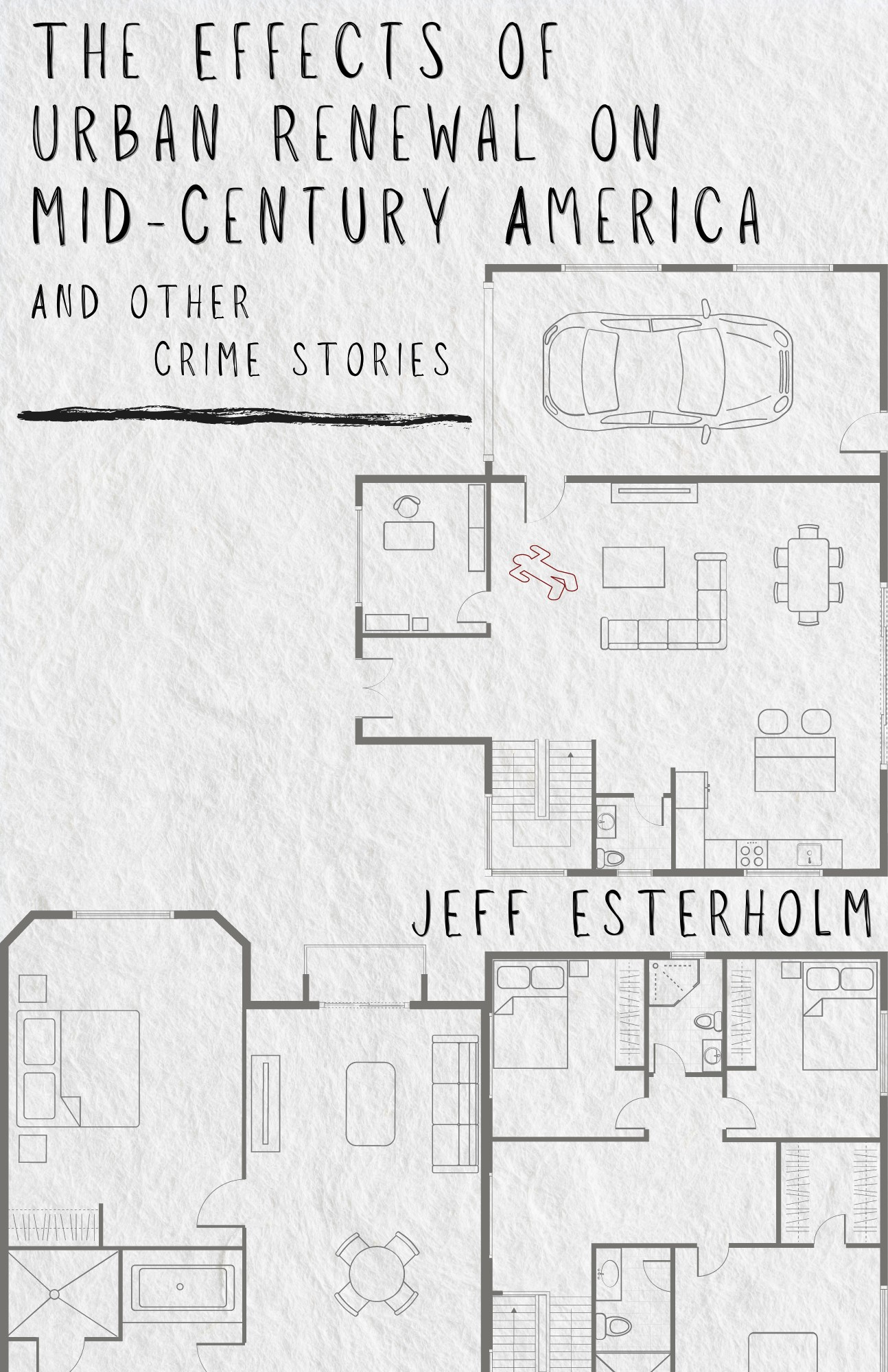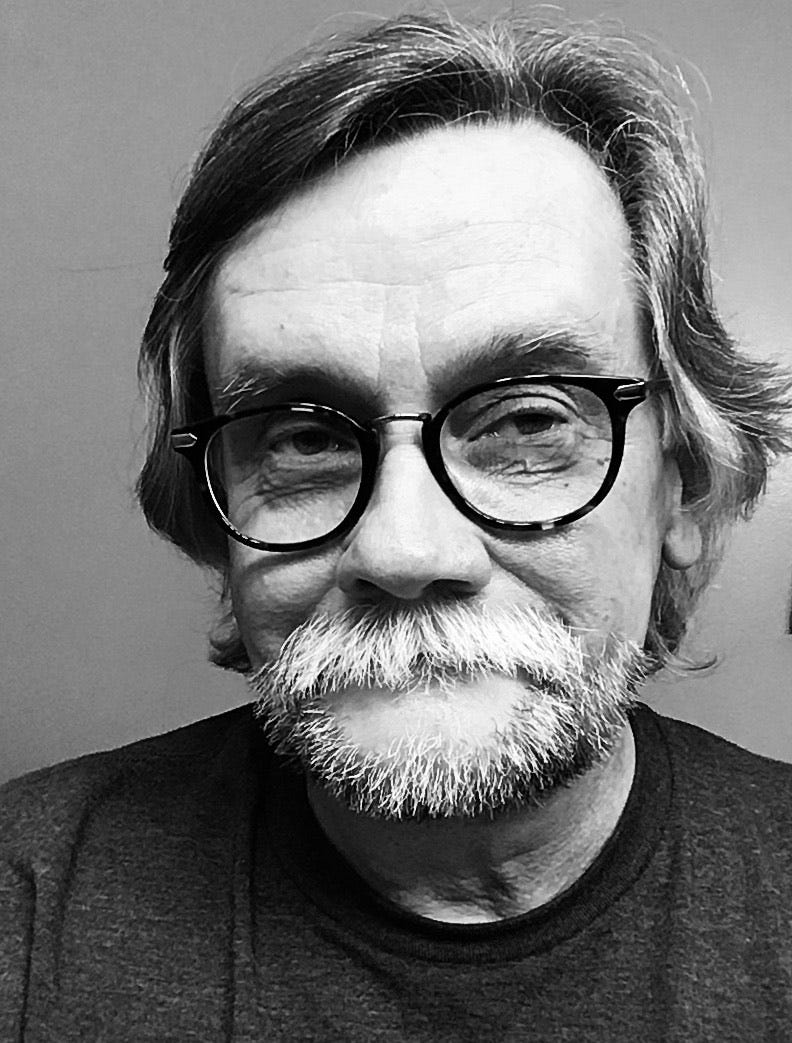I should’ve known before I sent these questions over to Jeff Esterholm that he was also a fan of Edward P. Jones’ short fiction. In his debut, The Effects of Urban Renewal on Mid-Century America and Other Crime Stories, out last year from Cornerstone Press, Esterholm moves like Jones with a magisterial confidence through time, seemingly knowing every dark corner of his characters’ inner lives. Set over a span of more than half a century, from 1941 to the present day, Esterholm’s collection reads like the secret history of a place. Most of the stories are set in and around Port Nicolett, a fictional city in Northern Wisconsin; in the handful that aren’t, characters leave the region, but the outside world only throws Esterholm’s Midwest into sharper relief.
I’ve been a fan of Esterholm’s short fiction since I first encountered it in the genre magazines I read and submit my work to. I thought we had a similar sensibility, as we both write—and presumably read—stories that sit on the margins of genre and literary fiction. I also liked the way Jeff handled setting. I’ve always felt like the best way to get to know a place is to find a detective novel series set there. Every one of Esterholm’s stories is rich with vivid, particular details of the time and place in which it is set. We hear the setting, also, in the way his characters talk, in his narrator’s diction, the voices of these stories.
I’m grateful to Jeff for taking a few minutes to talk to me about his book, the time and place he’s writing about, his process as a writer, and his influences.
Tom Andes: Setting is important in these stories, the place but also the time. Many feel like they’re evoking a vanished Middle America, or a vanished Upper Midwest. I was wondering if you could talk about the importance of place to you as a writer and how you go about evoking it so vividly.
Jeff Esterholm: I moved back to my hometown, Superior, Wisconsin, at the head of the Great Lakes, about nine years ago. The stories I wrote prior to and after the move back are in many instances set in Superior and in Port Nicollet, a fictional city on the south shore of Lake Superior. Even if the big lake isn’t directly mentioned, its weather, emotionally and physically, permeates my short stories. It’s tied up inextricably with the words. As to evoking the area vividly, thank you, Tom. I credit that to a lot of walking, some hitchhiking in the Twin Ports of Superior and Duluth, no wheels, before I moved away in the late seventies—like just about any kid at 22, vowing never to return to their hometown again. All the while I guess I was quietly observing the Twin Ports, listening to the people here. I also gleaned plenty of the area’s history from my parents, both now in their nineties, a history that extends from the 1930s: that there used to be streetcar lines, the location of neighborhood grocers and butchers, the changes in interstate bridge systems, Duluth, Minnesota, situated just across the way. I ate all this up and it helps, I believe, the words on the page come alive. For what it’s worth, a certain Nobel laureate, born across the Saint Louis River in Duluth, mentions Superior in his autobiography: “Near Duluth, I also had cousins across the suspension aerial bridge in Superior, Wisconsin, the notorious red-light, gambling town…” He goes on to quite colorfully write about the Twin Ports and life by the lake.
TA: As an adjunct to that question, I wondered what attracted you to writing about the time period in which these stories are set, mostly the 1940s to the 1980s, I think.
JE: Yes, primarily that period, but a healthy chunk of the last quarter of the collection somehow made it into this century. The forties to the eighties: I guess in the fictional world I choose to work in I’m more intrigued by a time that doesn’t rely on technology to move the story along—tablets and computers and phones, phones that pull extra duty as still and movie cameras, radios, movie theaters in miniature. Among other things. I guess it’s a little like that song by The Kinks, “20thCentury Man”: This is the age of machinery/A mechanical nightmare. The song’s over fifty years old. It still plays quite well, has a bit of a bite. That said, I’m not a Luddite by any stretch.
TA: I especially love the concrete details in the stories, the makes and models of the cars, the brands of milk. Are those the product of research or recall?
JE: Thank you. I like to see that because too often I’ve heard or read, “Don’t use product names. It will just date the story and readers won’t know what you’re talking about. What’s a DuMont television? Tell the reader what it is.” But I like the detail. It comes from a little bit of both, research and recall, and more weighted towards research when, for example, I want to be sure about the make and model of a car from the forties or fifties. That 1951 Studebaker Champion Starlight coupe that I want to use, did it look like the one Great-grandpa Claude drove around in Duluth all those years ago? Plus, you can’t beat the car’s name: Studebaker Champion Starlight.
TA: I’ve heard it said that historical fiction isn’t about the era it’s set in so much as it is the time it’s written in. Not that you’re writing historical fiction. But what do you think you’re saying about our era with these stories?
JE: You know, I’d never really thought too hard about that when writing the stories, but then the concept crystallized when I assembled the collection for my publisher, Cornerstone Press. The last good time for this particular Great Lakes region was the shipbuilding era during the two world wars. After the boom, there was the big good-paying jobs fadeout. Essentially, it’s what happens when people become economically unmoored after there had been expectations generations before of good times being just up ahead. They’re left to their own devices, some not making the best choices. I think the area is still watching for those good times up around the bend.
TA: According to the book’s title, these are crime stories. What made you decide to write in the crime genre, and why did you think it was the right genre to tell the stories you wanted to tell?
JE: When I started reading the Akashic Books city-related noir series, man, I found that to be right smack in my wheelhouse. Those stories checked boxes on the list: the specificity of place, a prevailing darkness, and sometimes a rich flash of humor. It was a great creative spark for me after writing in a more mainstream, say, literary genre for years. Why is crime the right genre? It feels right to me. It’s the difference between telling the story of a guy who sells scrap metal in attempt to supplement his family’s income and the story of a guy who, while still wanting to supplement the household’s kitty, cops a neighborhood gang’s stolen scrap metal. Something is going to happen.
TA: Taken together, these stories feel like the secret history of a place. Had you always envisioned this as a book-length project, or did that evolve over the course of writing individual stories?
JE: I was writing the stories individually, editing, revising, submitting, resubmitting, and they were landing in cool venues: Tough, Vautrin, Rock and a Hard Place. A few years ago, I decided to assemble some of what I had into a collection and that was when I saw how they fit together. That secret history of a place you mentioned. How to order the stories? I went by the year each story was set in, so the first one in the book, “Frenesí,” is in 1941 and the final story, “Blomfeldt’s Paperboy,” has a contemporary setting.
TA: I also think the POV in these stories is really interesting, the freedom you allow yourself to foreshadow, to talk about events that happen years later. How did you evolve that style?
JE: That’s come about through trial and error and reading, with a big tip of the hat to Edward P. Jones’s brilliant short stories in his books Lost in the City and All Aunt Hagar’s Children. It’s been almost twenty years since I read those books, so they’re due a reread. I love his use of language and time, and how he can describe, for example, in “Common Law,” in one paragraph, a woman’s life—one and a half years in the future, eight years, twenty years, thirty years, more than forty years—as the man driving her to work talks about the immediate future he is planning with his fiancée.
TA: Who are your biggest influences writing this book, and who are you reading now?
JE: I would say that William Boyle and his novels set in Brooklyn, and Anthony Bukoski, with his short story collections set in Superior’s East End neighborhood, are huge influences. They’re both masters of place and time in their fiction. I should also mention my first creative writing professor, the late George Gott. He gently encouraged me to move away from the sophomoric poetry I was writing—more like poor rock and roll lyrics—and stick to the short fiction I’d been showing him. A good man and teacher. I recently finished reading Duane Swierczynski’s California Bear, set in the LA, by turns a harrowing read and laugh out loud fun, just full of heart. I’m currently reading Stephen Mack Jones’s August Snow, another good one for the setting of place, Detroit—and his use of food, is it incidental? I don’t know, but it makes me hungry every time the plate is set in front of me as a reader.




Tom this is great. Definitely going to look for this book especially with my Wisconsin connection. Great questions.